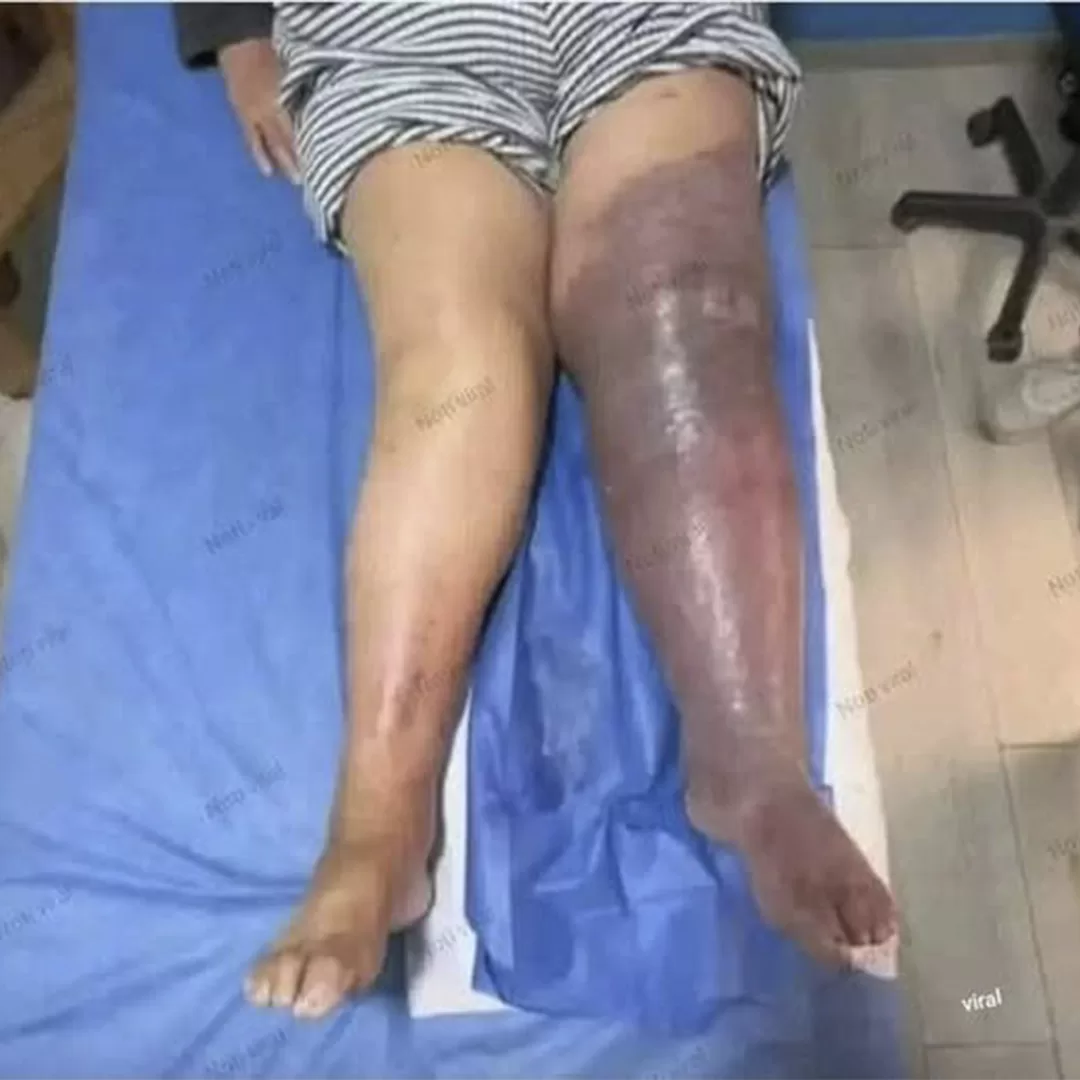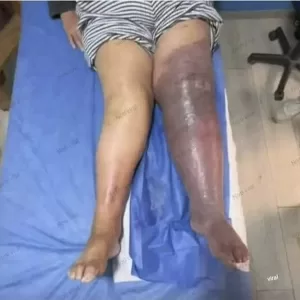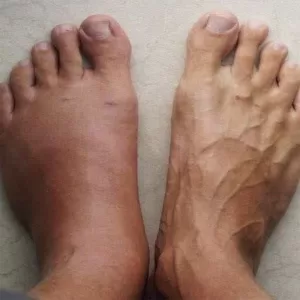

Sometimes the body speaks to us in very clear ways, and one of them is when a leg begins to swell excessively and changes color until it appears purple or bruised. This situation is not only alarming to the eye, but it’s also a sign that something serious may be happening in the body. It’s not a simple “bump” or something that should be ignored and waited for to resolve itself.
Anyone who has experienced this knows how shocking it is to see one of their legs swell so much that it’s twice the size of the other, with a dark color reminiscent of a giant hematoma. Pain, heaviness, and difficulty walking are symptoms that accompany this condition and should be an immediate warning to seek medical attention.


📌 IMPORTANT: You’ll find the video related to this story at the end of the article.
Why can something like this happen?
Swelling and discoloration of a leg are often related to circulatory problems. The most common causes include:
- Deep vein thrombosis (DVT):This occurs when a clot forms in a deep vein, usually in the leg. This clot prevents blood from flowing properly, causing swelling, pain, and a purplish color. It’s a serious condition because the clot can break loose and travel to the lungs, causing a pulmonary embolism.
- Chronic venous insufficiency:When the valves in your veins don’t work properly, blood pools in your legs. Over time, this causes swelling, skin changes, and dark spots.
- Lymphedema:This is a buildup of lymphatic fluid in the tissues due to blockages in the lymphatic system. This not only causes the leg to swell, but also makes it stiff and heavy.
- Severe infections (cellulitis):Some bacterial infections of the skin and soft tissues can cause severe redness, pain, and, if left untreated, progress to a darker color.
- Heart, kidney, or liver problems:In some patients, failure of these organs can cause fluid retention and leg swelling, although not always with such a marked color change.



Symptoms that accompany this condition
In addition to swelling and purpleness, people often experience:
- Pain or sensitivity to touch.
- Sensation of heat in the affected leg.
- Difficulty walking or moving the leg.
- Tight, shiny, or stretched-looking skin.
- In more severe cases, fever and general malaise (when there is infection).


The risk of not acting in time
The most dangerous thing about these types of cases is underestimating them. Some people believe it’s just a blow, temporary “poor circulation,” or a problem that will resolve itself with rest. However, underlying the problem may be a blood clot that, if left undetected, can lead to life-threatening complications.
Deep vein thrombosis , in particular, is one of the most feared emergencies in vascular medicine. If a clot travels to the lungs, it can block circulation and cause a pulmonary embolism, a condition that requires immediate attention and can be fatal.


How is it diagnosed?
When a person comes to the doctor with this condition, the first step is to rule out thrombosis. To do this, tests such as:
- Doppler ultrasound:allows you to see if the blood is circulating correctly in the veins.
- Blood test (D-dimer):measures substances that indicate the presence of clots.
- Magnetic resonance imaging or CT:in more complex cases or when clots are suspected in deep areas.


Most frequent treatments
Treatment will depend on the exact cause, but common options include:
- Anticoagulants:Medications that prevent clots from growing or forming new ones. They are essential for deep vein thrombosis.
- Compression stockings:help improve circulation in people with venous insufficiency.
- Lymphatic drainage:In cases of lymphedema, specialized massages and bandages are used to reduce fluid accumulation.
- Antibiotics:If the cause is an infection such as cellulitis, treatment with intravenous antibiotics is usually essential.
- Surgery or interventions:In some severe cases, it is necessary to place filters in the vena cava or perform surgical procedures to remove clots.



The importance of prevention
Although such a problem cannot always be prevented, there are measures that can help reduce the risk, especially of thrombosis:
- Keep moving, avoiding spending many hours sitting or standing still.
- Wear compression stockings if you have a history of circulatory problems.
- Stay well hydrated during long plane or road trips.
- Do not smoke, as tobacco increases the risk of blood clots.
- Maintain a healthy weight and exercise regularly.



People at higher risk
Some groups are more likely to suffer from thrombosis or lymphedema:
- People with a family history of circulatory problems.
- Patients who have recently undergone surgery, especially hip or knee surgery.
- People who remain immobilized for a long time due to illness or prolonged rest.
- Pregnant women or women taking hormonal contraceptives.
- Cancer patients, since this disease increases blood clotting.


The emotional and social impact
Beyond the physical, seeing such a swollen, dark leg has a strong emotional impact. Many people experience fear, anxiety, and even depression when faced with a diagnosis of thrombosis or chronic lymphedema. Furthermore, the limitations on walking or performing daily activities can lead to frustration and even social isolation.
Therefore, in addition to medical treatment, it is important to provide psychological support and guidance to those experiencing this situation.



Final reflection
When a leg swells to the point of purple, it’s not just a cosmetic problem or a temporary discomfort. It’s a clear warning from the body that circulation is compromised and immediate medical attention is needed.
The good news is that with early diagnosis and proper treatment, many of these conditions can be controlled and serious complications avoided. The big mistake is waiting too long or self-medicating.



Let’s remember that our legs support us every day. If they speak to us through pain, swelling, or discoloration, the wisest thing to do is listen to them and see a specialist without delay.